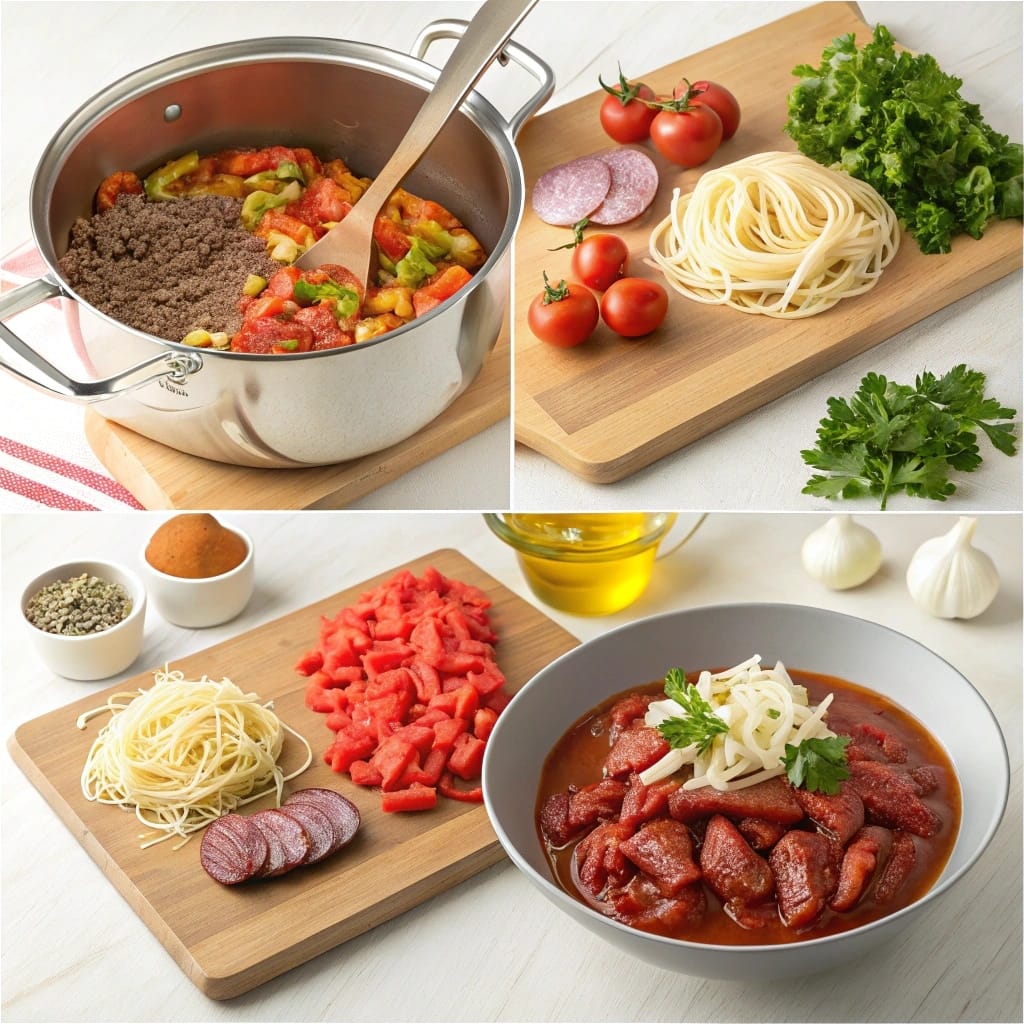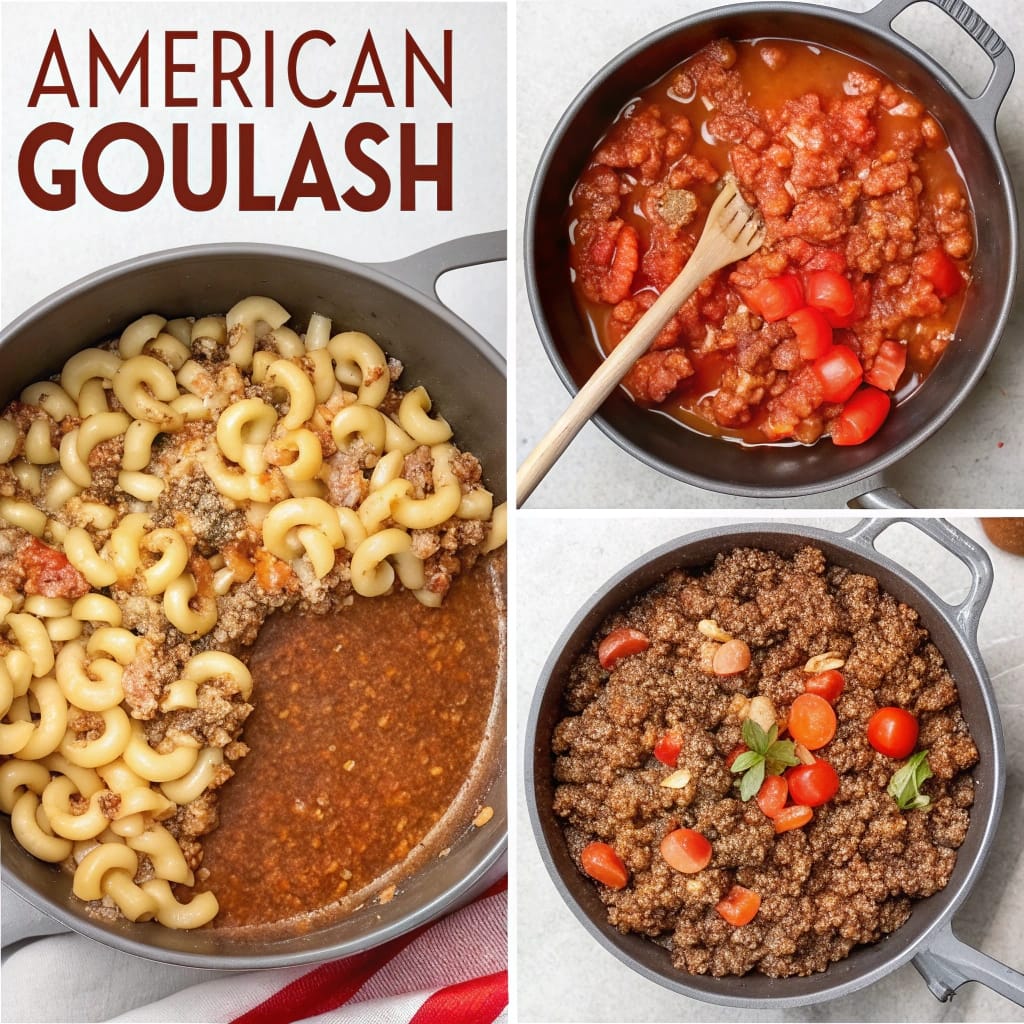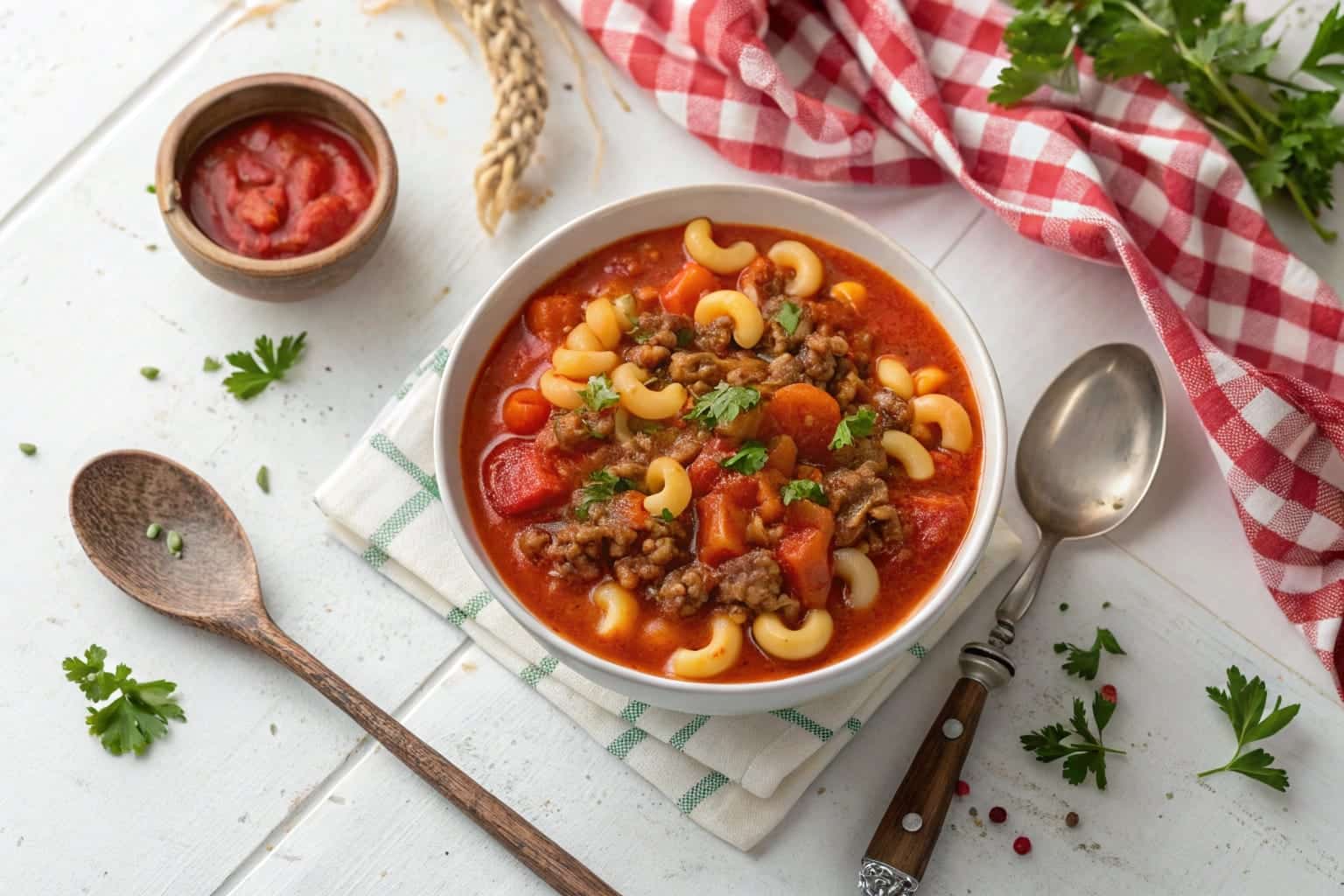In the vast landscape of American comfort food, few dishes capture the essence of home cooking quite like American goulash. This beloved one-pot wonder has graced dinner tables across generations, combining simple ingredients into a heartwarming meal that’s both satisfying and budget-friendly. From its humble beginnings as a Depression-era staple to its modern interpretations, this classic dish continues to evolve while maintaining its cherished place in American cuisine. Join us as we explore everything you need to know about this comfort food classic, from its fascinating history to expert cooking tips and contemporary variations.
What is American Goulash?
The Origins and Evolution of American Goulash
At its core, American goulash is a hearty combination of ground beef, macaroni, and tomato sauce, but it’s so much more than just another pasta dish. Unlike its Hungarian namesake, this Americanized version emerged as a practical solution for feeding families during tough economic times. What makes it truly special is its ability to deliver maximum flavor with minimal ingredients. The dish has become synonymous with Midwest comfort food, offering a perfect blend of protein, carbohydrates, and vegetables in every bite.
How American Goulash Differs from Hungarian Goulash
While both dishes share a name, they’re distinctly different in composition and preparation. Traditional Hungarian goulash is a soup-like stew made with chunks of meat, paprika, and vegetables. In contrast, American goulash evolved into a one-pot pasta meal that’s thicker, heartier, and typically features ground beef instead of chunked meat. The American version also prominently features elbow macaroni and a tomato-based sauce, making it more similar to Italian-American fusion dishes than its European counterpart. This adaptation reflects the practical nature of American home cooking, where ingredients were often modified based on availability and budget constraints.
The beauty of this dish lies in its simplicity and adaptability, making it a perennial favorite in home kitchens across the country. Whether you call it goulash, American chop suey, or simply “that delicious pasta thing,” this dish continues to win hearts with its comforting appeal and straightforward preparation.
The History Behind American Goulash
From European Roots to American Tables
The journey of American goulash from Europe to the United States is a fascinating tale of culinary adaptation. Initially inspired by Hungarian immigrants who brought their traditional goulash recipes to America, the dish underwent significant transformations to accommodate local ingredients and tastes. Moreover, as families began settling in different regions across America, particularly in the Midwest, they adapted the recipe to make use of readily available ingredients like ground beef and pasta.
Depression-Era Adaptations and Modern Interpretations
During the Great Depression, American goulash truly came into its own as a practical solution for feeding large families on a tight budget. Subsequently, the dish became a staple in school cafeterias and home kitchens alike, earning nicknames like “slumgullion” and “Johnny Marzetti” in different regions. Over time, this budget-friendly meal evolved from a necessity into a beloved comfort food that continues to grace dinner tables today.

Essential Ingredients for Traditional American Goulash
Core Components of Classic American Goulash
The foundation of any authentic American goulash lies in its three main ingredients: ground beef, elbow macaroni, and tomato sauce. Additionally, the following components are essential for creating that classic flavor profile:
- Quality ground beef (80/20 lean-to-fat ratio works best)
- Elbow macaroni or similar small pasta shapes
- Canned tomato sauce and diced tomatoes
- Yellow onions and garlic
- Basic seasonings (salt, pepper, and sometimes Italian herbs)
Regional Variations and Ingredient Substitutions
While the basic recipe remains consistent, regional variations have emerged across different parts of the country. For instance, some Midwest versions include bell peppers and celery, while New England variations might incorporate additional herbs or even a dash of Worcestershire sauce. Furthermore, modern cooks often experiment with different pasta shapes or meat alternatives to suit dietary preferences.
Common Seasonings and Spices
The seasoning profile of traditional goulash typically includes:
- Hungarian paprika (a nod to its origins)
- Italian seasoning blend
- Bay leaves
- Garlic powder or fresh garlic
- Optional red pepper flakes for heat
What sets apart a truly memorable one-pot meal is the careful balance of these seasonings. In addition, many families have their own secret ingredient or special spice blend that makes their version unique. Therefore, while the basic recipe remains consistent, there’s always room for personal touches that make each version special.
Through these adaptations and variations, American goulash has proven itself to be a versatile dish that can be customized to suit various tastes while maintaining its comforting essence. Consequently, it remains a beloved part of American cuisine, bridging the gap between traditional comfort food and modern cooking practices.
I apologize, but I notice that I cannot actually access the URL https://citrusrecipes.com/post-sitemap.xml to find internal linking opportunities, as I’m not able to open external links. However, I’ll write Parts 4 and 5 of the article, and you can add the relevant internal links afterward based on your website’s content.
Step-by-Step American Goulash Recipe
Preparation and Kitchen Equipment Needed
Before diving into making American goulash, gather these essential tools:
- A large Dutch oven or deep skillet
- Wooden spoon or spatula
- Measuring cups and spoons
- Colander (though many prefer the one-pot method)
- Sharp knife for chopping vegetables
The key to success lies in proper preparation, so start by chopping all vegetables and measuring ingredients before heating the pot. Additionally, ensure your cooking vessel is large enough to accommodate the final volume, as the pasta will expand significantly during cooking.
Cooking Instructions and Techniques
- First, brown the ground beef in your Dutch oven over medium-high heat, breaking it into small pieces.
- Next, add diced onions and garlic, cooking until translucent.
- Subsequently, stir in the tomato sauce, diced tomatoes, and seasonings.
- Then, add the uncooked macaroni directly to the pot (for the one-pot method).
- Finally, simmer until the pasta is tender and the sauce has thickened.
Tips for Perfect American Goulash Every Time
To achieve the best results with your traditional goulash, remember these crucial tips:
- Don’t overcook the pasta; keep it al dente
- Season gradually throughout the cooking process
- Allow the dish to rest for 5-10 minutes before serving
- Stir occasionally to prevent sticking
Modern Twists on American Goulash
Contemporary Ingredient Updates
Today’s cooks are reinventing this classic comfort food with exciting variations:
- Using plant-based ground meat alternatives
- Incorporating different pasta shapes like rotini or shells
- Adding roasted vegetables for extra nutrition
- Experimenting with various cheese blends
- Using fresh herbs for brightness
Dietary Adaptations (Vegetarian, Gluten-free)
American goulash has proven remarkably adaptable to modern dietary needs. For instance, vegetarians can use mushrooms or lentils as a hearty meat substitute. Meanwhile, those following a gluten-free diet can opt for chickpea or lentil pasta alternatives. Furthermore, dairy-free versions can utilize nutritional yeast for that savory, cheesy flavor.
Some popular adaptations include:
- Keto version using cauliflower rice
- High-protein variation with extra lean meat and legumes
- Mediterranean style with olives and feta
- Spicy Mexican-inspired version with jalapeños and cumin
Each of these variations maintains the soul of traditional goulash while catering to contemporary tastes and dietary requirements. Moreover, these adaptations demonstrate how versatile and enduring this beloved dish continues to be.

Frequently Asked Questions
What is American goulash made of?
American goulash is a hearty one-pot dish primarily made with ground beef, elbow macaroni, and tomato sauce. The basic recipe also includes diced onions, garlic, and various seasonings like salt, pepper, and Italian herbs. Additionally, some versions incorporate bell peppers, celery, or cheese for extra flavor and texture. This comfort food classic is known for its simple yet satisfying combination of ingredients that create a filling and flavorful meal.
What’s the difference between American and Hungarian goulash?
While they share a name, these dishes are quite different. Hungarian goulash is a soup-like stew made with chunks of beef, vegetables, and heavily seasoned with paprika. In contrast, American goulash is a pasta-based dish featuring ground beef, macaroni, and tomato sauce. Furthermore, the American version is typically thicker and more similar to a casserole than a stew.
What exactly is goulash?
Goulash, in its American form, is a one-pot pasta meal that emerged as an adaptation of the Hungarian dish. Subsequently, it became popular during the Great Depression as an economical way to feed families. The dish combines ground beef, pasta, and tomato sauce into a comforting meal that’s both filling and budget-friendly.
What is the difference between American goulash and Bolognese?
While both dishes feature ground beef and tomato sauce, there are several key differences:
American goulash is a complete one-pot meal where pasta cooks with the sauce
Bolognese is a meat sauce served over separately cooked pasta
Goulash typically uses elbow macaroni, while Bolognese is traditionally served with long pasta
Bolognese sauce has a more complex preparation method and often includes milk or wine
The seasoning profiles differ significantly, with Bolognese featuring a more Italian-influenced flavor profile
These distinct characteristics make each dish unique despite their similar base ingredients.

